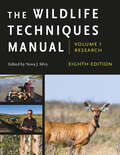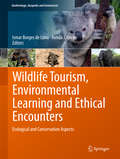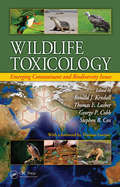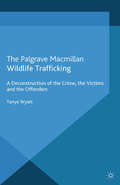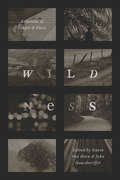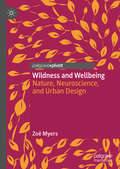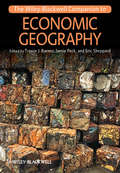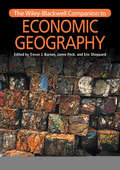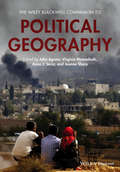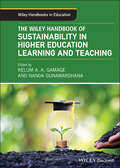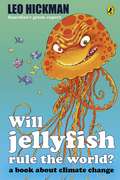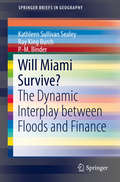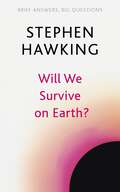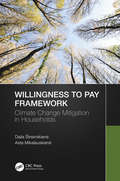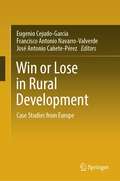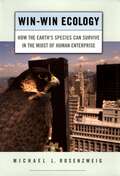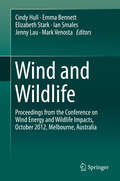- Table View
- List View
The Wildlife Techniques Manual: Volume 1: Research. Volume 2: Management
by Nova J. SilvySince its original publication in 1960, The Wildlife Techniques Manual has remained the cornerstone text for the professional wildlife biologist. Now fully revised and updated, this eighth edition promises to be the most comprehensive resource on wildlife biology, conservation, and management for years to come. Superbly edited by Nova J. Silvy and published in association with The Wildlife Society, the 50 authoritative chapters included in this work provide a full synthesis of methods used in the field and laboratory. Chapter authors, all leading wildlife professionals, explain and critique traditional and new methodologies and offer thorough discussions of a wide range of relevant topics. To effectively incorporate the explosion of new information in the wildlife profession, this latest edition is logically organized into a 2-volume set: Volume 1 is devoted to research techniques and Volume 2 focuses on pragmatic management methodologies. Volume 1 describes research design and proper analytic methods prior to conducting research, as well as methods and considerations for capturing and handling wild animals and information on identification and marking of captured animals. It also includes new chapters on nutritional research and field sign identification, and on emerging topics, including structured decision-making. Finally, Volume 1 addresses measurements of wildlife abundance and habitat and research on individual animals. Volume 2 begins with a section on the relationship between research and management including public outreach, described in a context that encourages engagement prior to initiation of management. An adaptive management approach is described as a cornerstone of natural resource management, followed by a section on managing landscapes and wildlife populations. The volume also includes new chapters on ethics in wildlife science and conservation, conflict resolution and management, and land reclamation. A standard text in a variety of courses, the Techniques Manual, as it is commonly called, covers every aspect of modern wildlife management and provides practical information for applying the hundreds of methods described in its pages. This deft and thorough update ensures that The Wildlife Techniques Manual will remain an indispensable resource, one that professionals and students in wildlife biology, conservation, and management simply cannot do without.
Wildlife Tourism, Environmental Learning and Ethical Encounters: Ecological and Conservation Aspects (Geoheritage, Geoparks and Geotourism)
by Ismar Borges de Lima Ronda J. GreenThis book outlines the status quo of worldwide wildlife tourism and its impacts on planning, management, knowledge, awareness, behaviour and attitudes related to wildlife encounters. It sets out to fill the considerable gaps in our knowledge on wildlife tourism, applied ecology, and environmental education, providing comprehensive information on and an interdisciplinary approach to effective management in wildlife tourism. Examining the intricacies, challenges, and lessons learned in a meaningful and rewarding tourism niche, this interdisciplinary book comprehensively examines the major potentials and controversies in the wildlife tourism industry. Pursuing an insightful, provocative and hands-on approach, it primarily addresses two questions: ‘Can we reconcile the needs of the wildlife tourism industry, biodiversity conservation, ecological learning and animal ethics issues?’ and ‘What is the Future of the Wildlife Tourism Industry?’. Though primarily intended as a research text, it also offers a valuable resource for a broad readership, which includes university and training students, researchers, scholars, tourism practitioners and professionals, planners and managers, as well as the staff of government agencies.
Wildlife Toxicology: Emerging Contaminant and Biodiversity Issues
by Ronald J. Kendall Thomas E. Lacher George C. Cobb Stephen Boyd CoxUpdating the extremely successful Wildlife Toxicology and Population Modeling (CRC Press, 1994), Wildlife Toxicology: Emerging Contaminant and Biodiversity Issues brings together a distinguished group of international contributors, who provide a global assessment of a range of environmental stressors, including pesticides, environmental contaminant
Wildlife Trafficking: A Deconstruction of the Crime, the Victims, and the Offenders (Critical Criminological Perspectives)
by T. WyattThis book provides a unique, comprehensive exploration of the scale, scope, threats and drivers of wildlife trafficking. It also undertakes a distinctive exploration of who the victims and offenders of wildlife trafficking are as well as analysing the stakeholders who are involved in collaborative efforts to end this devastating green crime.
Wildness: Relations of People and Place
by Gavin Van Horn and John Hausdoerffer John HausdoerfferWhether referring to a place, a nonhuman animal or plant, or a state of mind, wild indicates autonomy and agency, a will to be, a unique expression of life. Yet two contrasting ideas about wild nature permeate contemporary discussions: either that nature is most wild in the absence of a defiling human presence, or that nature is completely humanized and nothing is truly wild. This book charts a different path. Exploring how people can become attuned to the wild community of life and also contribute to the well-being of the wild places in which we live, work, and play, Wildness brings together esteemed authors from a variety of landscapes, cultures, and backgrounds to share their stories about the interdependence of everyday human lifeways and wildness. As they show, far from being an all or nothing proposition, wildness exists in variations and degrees that range from cultivated soils to multigenerational forests to sunflowers pushing through cracks in a city alley. Spanning diverse geographies, these essays celebrate the continuum of wildness, revealing the many ways in which human communities can nurture, adapt to, and thrive alongside their wild nonhuman kin. From the contoured lands of Wisconsin’s Driftless region to remote Alaska, from the amazing adaptations of animals and plants living in the concrete jungle to indigenous lands and harvest ceremonies, from backyards to reclaimed urban industrial sites, from microcosms to bioregions and atmospheres, manifestations of wildness are everywhere. With this book, we gain insight into what wildness is and could be, as well as how it might be recovered in our lives—and with it, how we might unearth a more profound, wilder understanding of what it means to be human. Wildness: Relations of People and Place is published in association with the Center for Humans and Nature, an organization that brings together some of the brightest minds to explore and promote human responsibilities to each other and the whole community of life. Visit the Center for Humans and Nature's Wildness website for upcoming events and a series of related short films.
Wildness: Relations of People and Place
by Gavin Van Horn and John Hausdoerffer John HausdoerfferWhether referring to a place, a nonhuman animal or plant, or a state of mind, wild indicates autonomy and agency, a will to be, a unique expression of life. Yet two contrasting ideas about wild nature permeate contemporary discussions: either that nature is most wild in the absence of a defiling human presence, or that nature is completely humanized and nothing is truly wild. This book charts a different path. Exploring how people can become attuned to the wild community of life and also contribute to the well-being of the wild places in which we live, work, and play, Wildness brings together esteemed authors from a variety of landscapes, cultures, and backgrounds to share their stories about the interdependence of everyday human lifeways and wildness. As they show, far from being an all or nothing proposition, wildness exists in variations and degrees that range from cultivated soils to multigenerational forests to sunflowers pushing through cracks in a city alley. Spanning diverse geographies, these essays celebrate the continuum of wildness, revealing the many ways in which human communities can nurture, adapt to, and thrive alongside their wild nonhuman kin. From the contoured lands of Wisconsin’s Driftless region to remote Alaska, from the amazing adaptations of animals and plants living in the concrete jungle to indigenous lands and harvest ceremonies, from backyards to reclaimed urban industrial sites, from microcosms to bioregions and atmospheres, manifestations of wildness are everywhere. With this book, we gain insight into what wildness is and could be, as well as how it might be recovered in our lives—and with it, how we might unearth a more profound, wilder understanding of what it means to be human. Wildness: Relations of People and Place is published in association with the Center for Humans and Nature, an organization that brings together some of the brightest minds to explore and promote human responsibilities to each other and the whole community of life. Visit the Center for Humans and Nature's Wildness website for upcoming events and a series of related short films.
Wildness: Relations of People and Place
by Gavin Van Horn and John Hausdoerffer John HausdoerfferWhether referring to a place, a nonhuman animal or plant, or a state of mind, wild indicates autonomy and agency, a will to be, a unique expression of life. Yet two contrasting ideas about wild nature permeate contemporary discussions: either that nature is most wild in the absence of a defiling human presence, or that nature is completely humanized and nothing is truly wild. This book charts a different path. Exploring how people can become attuned to the wild community of life and also contribute to the well-being of the wild places in which we live, work, and play, Wildness brings together esteemed authors from a variety of landscapes, cultures, and backgrounds to share their stories about the interdependence of everyday human lifeways and wildness. As they show, far from being an all or nothing proposition, wildness exists in variations and degrees that range from cultivated soils to multigenerational forests to sunflowers pushing through cracks in a city alley. Spanning diverse geographies, these essays celebrate the continuum of wildness, revealing the many ways in which human communities can nurture, adapt to, and thrive alongside their wild nonhuman kin. From the contoured lands of Wisconsin’s Driftless region to remote Alaska, from the amazing adaptations of animals and plants living in the concrete jungle to indigenous lands and harvest ceremonies, from backyards to reclaimed urban industrial sites, from microcosms to bioregions and atmospheres, manifestations of wildness are everywhere. With this book, we gain insight into what wildness is and could be, as well as how it might be recovered in our lives—and with it, how we might unearth a more profound, wilder understanding of what it means to be human. Wildness: Relations of People and Place is published in association with the Center for Humans and Nature, an organization that brings together some of the brightest minds to explore and promote human responsibilities to each other and the whole community of life. Visit the Center for Humans and Nature's Wildness website for upcoming events and a series of related short films.
Wildness: Relations of People and Place
by Gavin Van Horn John HausdoerfferWhether referring to a place, a nonhuman animal or plant, or a state of mind, wild indicates autonomy and agency, a will to be, a unique expression of life. Yet two contrasting ideas about wild nature permeate contemporary discussions: either that nature is most wild in the absence of a defiling human presence, or that nature is completely humanized and nothing is truly wild. This book charts a different path. Exploring how people can become attuned to the wild community of life and also contribute to the well-being of the wild places in which we live, work, and play, Wildness brings together esteemed authors from a variety of landscapes, cultures, and backgrounds to share their stories about the interdependence of everyday human lifeways and wildness. As they show, far from being an all or nothing proposition, wildness exists in variations and degrees that range from cultivated soils to multigenerational forests to sunflowers pushing through cracks in a city alley. Spanning diverse geographies, these essays celebrate the continuum of wildness, revealing the many ways in which human communities can nurture, adapt to, and thrive alongside their wild nonhuman kin. From the contoured lands of Wisconsin’s Driftless region to remote Alaska, from the amazing adaptations of animals and plants living in the concrete jungle to indigenous lands and harvest ceremonies, from backyards to reclaimed urban industrial sites, from microcosms to bioregions and atmospheres, manifestations of wildness are everywhere. With this book, we gain insight into what wildness is and could be, as well as how it might be recovered in our lives—and with it, how we might unearth a more profound, wilder understanding of what it means to be human. Wildness: Relations of People and Place is published in association with the Center for Humans and Nature, an organization that brings together some of the brightest minds to explore and promote human responsibilities to each other and the whole community of life. Visit the Center for Humans and Nature's Wildness website for upcoming events and a series of related short films.
Wildness: Relations of People and Place
by Gavin Van Horn John HausdoerfferWhether referring to a place, a nonhuman animal or plant, or a state of mind, wild indicates autonomy and agency, a will to be, a unique expression of life. Yet two contrasting ideas about wild nature permeate contemporary discussions: either that nature is most wild in the absence of a defiling human presence, or that nature is completely humanized and nothing is truly wild. This book charts a different path. Exploring how people can become attuned to the wild community of life and also contribute to the well-being of the wild places in which we live, work, and play, Wildness brings together esteemed authors from a variety of landscapes, cultures, and backgrounds to share their stories about the interdependence of everyday human lifeways and wildness. As they show, far from being an all or nothing proposition, wildness exists in variations and degrees that range from cultivated soils to multigenerational forests to sunflowers pushing through cracks in a city alley. Spanning diverse geographies, these essays celebrate the continuum of wildness, revealing the many ways in which human communities can nurture, adapt to, and thrive alongside their wild nonhuman kin. From the contoured lands of Wisconsin’s Driftless region to remote Alaska, from the amazing adaptations of animals and plants living in the concrete jungle to indigenous lands and harvest ceremonies, from backyards to reclaimed urban industrial sites, from microcosms to bioregions and atmospheres, manifestations of wildness are everywhere. With this book, we gain insight into what wildness is and could be, as well as how it might be recovered in our lives—and with it, how we might unearth a more profound, wilder understanding of what it means to be human. Wildness: Relations of People and Place is published in association with the Center for Humans and Nature, an organization that brings together some of the brightest minds to explore and promote human responsibilities to each other and the whole community of life. Visit the Center for Humans and Nature's Wildness website for upcoming events and a series of related short films.
Wildness: Relations of People and Place
Whether referring to a place, a nonhuman animal or plant, or a state of mind, wild indicates autonomy and agency, a will to be, a unique expression of life. Yet two contrasting ideas about wild nature permeate contemporary discussions: either that nature is most wild in the absence of a defiling human presence, or that nature is completely humanized and nothing is truly wild. This book charts a different path. Exploring how people can become attuned to the wild community of life and also contribute to the well-being of the wild places in which we live, work, and play, Wildness brings together esteemed authors from a variety of landscapes, cultures, and backgrounds to share their stories about the interdependence of everyday human lifeways and wildness. As they show, far from being an all or nothing proposition, wildness exists in variations and degrees that range from cultivated soils to multigenerational forests to sunflowers pushing through cracks in a city alley. Spanning diverse geographies, these essays celebrate the continuum of wildness, revealing the many ways in which human communities can nurture, adapt to, and thrive alongside their wild nonhuman kin. From the contoured lands of Wisconsin’s Driftless region to remote Alaska, from the amazing adaptations of animals and plants living in the concrete jungle to indigenous lands and harvest ceremonies, from backyards to reclaimed urban industrial sites, from microcosms to bioregions and atmospheres, manifestations of wildness are everywhere. With this book, we gain insight into what wildness is and could be, as well as how it might be recovered in our lives—and with it, how we might unearth a more profound, wilder understanding of what it means to be human. Wildness: Relations of People and Place is published in association with the Center for Humans and Nature, an organization that brings together some of the brightest minds to explore and promote human responsibilities to each other and the whole community of life. Visit the Center for Humans and Nature's Wildness website for upcoming events and a series of related short films.
Wildness and Wellbeing: Nature, Neuroscience, and Urban Design
by Zoë MyersWildness and Wellbeing explores the dynamic relationships between urban nature and mental health, offering practical strategies for urban design. Mental health is a leading global issue and our urban environments can contribute to conditions such as depression and anxiety. Presenting the latest research, this book explores how neuroscience can offer new perspectives on the crucial role everyday multisensory interactions with nature can have on our mental wellbeing. These insights can help us (un)design our streets, neighbourhoods and cities, allowing nature to be integrated back into our cities. Wildness and Wellbeing is for anyone interested in the connections between urban ecology, health, environmental science, planning, and urban design, helping to create biodiverse cities for mental health.
The Wiley-Blackwell Companion to Economic Geography (Wiley Blackwell Companions to Geography #21)
by Trevor J. Barnes Jamie Peck Eric SheppardThe Wiley-Blackwell Companion to Economic Geography presents students and researchers with a comprehensive overview of the field, put together by a prestigious editorial team, with contributions from an international cast of prominent scholars. Offers a fully revised, expanded, and up-to-date overview, following the successful and highly regarded Companion to Economic Geography published by Blackwell a decade earlier, providing a comprehensive assessment of the field Takes a prospective as well as retrospective look at the field, reviewing recent developments, recurrent challenges, and emerging agendas Incorporates diverse perspectives (in terms of specialty, demography and geography) of up and coming scholars, going beyond a focus on Anglo-American research Encourages authors and researchers to engage with and contextualize their situated perspectives Explores areas of overlap, dialogues, and (potential) engagement between economic geography and cognate disciplines
The Wiley-Blackwell Companion to Economic Geography (Wiley Blackwell Companions to Geography #20)
by Trevor J. Barnes Jamie Peck Eric SheppardThe Wiley-Blackwell Companion to Economic Geography presents students and researchers with a comprehensive overview of the field, put together by a prestigious editorial team, with contributions from an international cast of prominent scholars. Offers a fully revised, expanded, and up-to-date overview, following the successful and highly regarded Companion to Economic Geography published by Blackwell a decade earlier, providing a comprehensive assessment of the field Takes a prospective as well as retrospective look at the field, reviewing recent developments, recurrent challenges, and emerging agendas Incorporates diverse perspectives (in terms of specialty, demography and geography) of up and coming scholars, going beyond a focus on Anglo-American research Encourages authors and researchers to engage with and contextualize their situated perspectives Explores areas of overlap, dialogues, and (potential) engagement between economic geography and cognate disciplines
The Wiley Blackwell Companion to Political Geography (Wiley Blackwell Companions to Geography)
by John A. Agnew Virginie Mamadouh Anna Secor Joanne SharpThe Wiley Blackwell Companion to Political Geography aims to account for the intellectual and worldly developments that have taken place in and around political geography in the last 10 years. Bringing together established names in the field as well as new scholars, it highlights provocative theoretical and conceptual debates on political geography from a range of global perspectives. Discusses the latest developments and places increased emphasis on modes of thinking, contested key concepts, and on geopolitics, climate change and terrorism Explores the influence of the practice-based methods in geography and concepts including postcolonialism, feminist geographies, the notion of the Anthropocene, and new understandings of the role of non-human actors in networks of power Offers an accessible introduction to political geography for those in allied fields including political science, international relations, and sociology
The Wiley Blackwell Companion to Political Geography (Wiley Blackwell Companions to Geography)
by John Agnew Virginie Mamadouh Anna J. Secor Joanne SharpThe Wiley Blackwell Companion to Political Geography aims to account for the intellectual and worldly developments that have taken place in and around political geography in the last 10 years. Bringing together established names in the field as well as new scholars, it highlights provocative theoretical and conceptual debates on political geography from a range of global perspectives. Discusses the latest developments and places increased emphasis on modes of thinking, contested key concepts, and on geopolitics, climate change and terrorism Explores the influence of the practice-based methods in geography and concepts including postcolonialism, feminist geographies, the notion of the Anthropocene, and new understandings of the role of non-human actors in networks of power Offers an accessible introduction to political geography for those in allied fields including political science, international relations, and sociology
The Wiley Handbook of Sustainability in Higher Education Learning and Teaching (Wiley Handbooks in Education)
by Kelum A. A. Gamage Nanda GunawardhanaA comprehensive resource for higher education professionals interested in sustainability pedagogy In The Wiley Handbook of Sustainability in Higher Education Learning and Teaching, a team of distinguished researchers delivers an insightful reference for higher education professionals seeking to embed sustainability in learning and teaching. The book offers a way for higher education institutions to implement sustainability goals in their curricula and provides comprehensive guidance to educators, researchers and practitioners. The authors discuss recent developments in technological innovations, best practices, lessons learned, current challenges, and reflections in the area of sustainability teaching in higher education. They also examine the impact of the COVID-19 pandemic on sustainability education. With contributors from a variety of disciplines, including engineering, medicine, urban design, business, environmental science, and social science, the book considers the embedding of sustainability in regenerative learning ecologies, living laboratories, and transgressive forms of learning. It also includes: A thorough introduction to activist learning for sustainability and outcome-based education towards achieving sustainable goals in higher education Comprehensive explorations of factors that hinder the implementation of sustainability initiatives in higher education institutions Practical discussions of developing stakeholder agency in higher education sustainability initiatives In-depth examinations of global trends and country-specific initiatives in sustainability teaching Perfect for education developers seeking to incorporate sustainability, The Wiley Handbook of Sustainability in Higher Education Learning and Teaching is also ideal for academics, researchers, policymakers, and accreditation personnel working in the area of sustainability.
The Wiley Handbook of Sustainability in Higher Education Learning and Teaching (Wiley Handbooks in Education)
by Kelum A. A. Gamage Nanda GunawardhanaA comprehensive resource for higher education professionals interested in sustainability pedagogy In The Wiley Handbook of Sustainability in Higher Education Learning and Teaching, a team of distinguished researchers delivers an insightful reference for higher education professionals seeking to embed sustainability in learning and teaching. The book offers a way for higher education institutions to implement sustainability goals in their curricula and provides comprehensive guidance to educators, researchers and practitioners. The authors discuss recent developments in technological innovations, best practices, lessons learned, current challenges, and reflections in the area of sustainability teaching in higher education. They also examine the impact of the COVID-19 pandemic on sustainability education. With contributors from a variety of disciplines, including engineering, medicine, urban design, business, environmental science, and social science, the book considers the embedding of sustainability in regenerative learning ecologies, living laboratories, and transgressive forms of learning. It also includes: A thorough introduction to activist learning for sustainability and outcome-based education towards achieving sustainable goals in higher education Comprehensive explorations of factors that hinder the implementation of sustainability initiatives in higher education institutions Practical discussions of developing stakeholder agency in higher education sustainability initiatives In-depth examinations of global trends and country-specific initiatives in sustainability teaching Perfect for education developers seeking to incorporate sustainability, The Wiley Handbook of Sustainability in Higher Education Learning and Teaching is also ideal for academics, researchers, policymakers, and accreditation personnel working in the area of sustainability.
Will Jellyfish Rule the World?: A Book About Climate Change
by Leo HickmanFrom what makes Earth so special, to how scientists know for sure our climate is changing, why it's a big deal for everyone and what we can all do right now to make a difference, green expert Leo Hickman is ready to answer all your questions.Will Jellyfish Rule the World? breaks down the causes and effects of climate change in a fresh, fun and easy-to-follow format. Packed with practical everyday things we can all do right now to make a difference, Will Jellyfish Rule the World? is a comprehensive, easy-to-use eco-handbook for budding classroom environmentalists everywhere.
Will Miami Survive?: The Dynamic Interplay between Floods and Finance (SpringerBriefs in Geography)
by Kathleen Sullivan Sealey Ray King Burch P. M. BinderThis SpringerBrief uses a complexity perspective to integrate risk, finance, and ecological issues in Miami, USA. It focuses on how the modern financial system, particularly the mortgage market, perceives and manages the risk of climate change. Authors Kathleen Sealey, Ray King Burch and P.-M. Binder offer the case study of South Florida to illustrate how landscapes can be either re-purposed to function ecologically when residents relocate or rebuilt to reduce the threat of future flooding, the tools needed to make these decisions, and how financial systems view and influence them. While the need to integrate financial markets into coastal (and environmental) management is increasingly recognized, the difficulty of this task is made greater by the speed of financial innovation and the obscurity and complexity of its practices. This book will discuss the innovative Southeast Florida Regional Climate Compact, and the success of public-private partnerships in planning and adapting to sea level rise, but also the broad disconnect with the cash-and-credit-driven real estate market of South Florida. The book presents an interdisciplinary approach to the understanding of the coupled human (including finance) and natural systems in coastal cities, thus breaking new ground in the approach towards sustainability research and education. The final chapter introduces the social component of resilience which include pre-disaster outreach with and the potential for decision theory to help people understand and manage risk.
Will We Survive on Earth? (Brief Answers, Big Questions)
by Stephen Hawking'Be brave, be curious, be determined, overcome the odds. It can be done'Will we survive on Earth?Should we colonise space?Throughout his extraordinary career, Stephen Hawking expanded our understanding of the universe and unravelled some of its greatest mysteries. In Will We Survive on Earth? the world-famous cosmologist and bestselling author of A Brief History of Time turns his attention to one of the most urgent issues for humankind and explores our options for survival.'Effortlessly instructive, absorbing and witty' GuardianBrief Answers, Big Questions: this stunning paperback series offers electrifying essays from one of the greatest minds of our age, taken from the original text of the No. 1 bestselling Brief Answers to the Big Questions.
Willingness to Pay Framework: Climate Change Mitigation in Households
by Dalia Štreimikienė Asta MikalauskienėThis book aims to develop a framework for the assessment of population ‘preferences in climate change mitigation policies by applying a Willingness to Pay (WTP) approach and presents the results from several case studies in Lithuania on renewable energy generation and renovation in different households. These analyses of climate change mitigation policies and measures, based on the assessment of their effectiveness, provide recommendations for developing innovative measures in other countries. Since public preferences are variable, climate change mitigation policies can change these preferences and allow to form new ones. Features: Analyses social benefits of climate change mitigation measures and their integration methods based on assessment of public preferences. Presents several practical case studies on energy needs where the Willingness to Pay framework was applied. Discusses climate change mitigation barriers in energy sector and the effectiveness of climate change mitigation policies to overcome them. Provides a novel approach for climate change mitigation policies development in households. Includes useful information for evaluating and planning policies related to renewable energy investment. This book is a useful reference for those in the academic, research, and business communities, policy makers, graduate students, and professionals involved with climate change mitigation projects.
Willingness to Pay Framework: Climate Change Mitigation in Households
by Dalia Štreimikienė Asta MikalauskienėThis book aims to develop a framework for the assessment of population ‘preferences in climate change mitigation policies by applying a Willingness to Pay (WTP) approach and presents the results from several case studies in Lithuania on renewable energy generation and renovation in different households. These analyses of climate change mitigation policies and measures, based on the assessment of their effectiveness, provide recommendations for developing innovative measures in other countries. Since public preferences are variable, climate change mitigation policies can change these preferences and allow to form new ones. Features: Analyses social benefits of climate change mitigation measures and their integration methods based on assessment of public preferences. Presents several practical case studies on energy needs where the Willingness to Pay framework was applied. Discusses climate change mitigation barriers in energy sector and the effectiveness of climate change mitigation policies to overcome them. Provides a novel approach for climate change mitigation policies development in households. Includes useful information for evaluating and planning policies related to renewable energy investment. This book is a useful reference for those in the academic, research, and business communities, policy makers, graduate students, and professionals involved with climate change mitigation projects.
Win or Lose in Rural Development: Case Studies from Europe
by Eugenio Cejudo-García Francisco Antonio Navarro-Valverde José Antonio Cañete-PérezThe aims of this book are: systematization and theorization of these projects; clarify and deepen the social and territorial effects of these initiatives; in-depth study of the causes that lead to the generation of successful projects in rural development; and abound in the reasons that lead specific projects to be failed in the access to LEADER support and be finally not implemented. This process of systematization and theorization would contribute to improving the decision-making in rural development, concretely the practice of these policies and initiatives. The book shows the problems, results and best practices that cause the rural development in different areas along with Europe. The multidisciplinary and international character of the authors in the analysis of rural development will enrich the publication and facilitate the different and critical reflections on the contributions, errors and meaning of these rural development practices.
Win-Win Ecology: How the Earth's Species Can Survive in the Midst of Human Enterprise
by Michael L. RosenzweigAs humanity presses down inexorably on the natural world, people debate the extent to which we can save the Earth's millions of different species without sacrificing human economic welfare. But is this argument wise? Must the human and natural worlds be adversaries? In this book, ecologist Michael Rosenzweig finds that ecological science actually rejects such polarization. Instead it suggests that, to be successful, conservation must discover how we can blend a rich natural world into the world of economic activity. This revolutionary, common ground between development and conservation is called reconciliation ecology: creating and maintaining species-friendly habitats in the very places where people live, work, or play. The book offers many inspiring examples of the good results already achieved. The Nature Conservancy, for instance, has a cooperative agreement with the Department of Defense, with more than 200 conservation projects taking place on more than 170 bases in 41 states. In places such as Elgin Air Force Base, the human uses-testing munitions, profitable timbering and recreation--continue, but populations of several threatened species on the base, such as the long-leaf pine and the red-cockaded woodpecker, have been greatly improved. The Safe Harbor strategy of the Fish & Wildlife Service encourages private landowners to improve their property for endangered species, thus overcoming the unintended negative aspects of the Endangered Species Act. And Golden Gate Park, which began as a system of sand dunes, has become, through human effort, a world of ponds and shrubs, waterfowl and trees. Rosenzweig shows that reconciliation ecology is the missing tool of conservation, the practical, scientifically based approach that, when added to the rest, will solve the problem of preserving Earth's species.
Wind and Wildlife: Proceedings from the Conference on Wind Energy and Wildlife Impacts, October 2012, Melbourne, Australia
by Cindy Hull Emma Bennett Elizabeth Stark Ian Smales Jenny Lau Mark VenostaThis book gathers papers presented and discussions held at the Conference on Wind Energy and Wildlife Impacts in Melbourne, Australia on 9th October 2012. The purpose of the conference was to bring together researchers, industry, consultants, regulators and Non-Government Organizations to share the results of studies into wind farm and wildlife investigations in Australia and New Zealand. The aim was to further networking and communication between these groups. The conference discussed key issues and areas for future investigation, with the intention of developing consistencies in research and management. Like the Conference, the book showcases current research and management in the field of wind farms and wildlife in Australia and New Zealand; establishes consistencies in research and management; and highlights areas in need of further examination. The papers in these Proceedings are presented in two session topics. The first covers “Investigations and assessment of new wind farms” and the second, “Monitoring, mitigation and offsets.”The Proceedings then summarize the panel discussions held at the end of the conference. The themes include improving pre- and post-construction survey design; identifying key knowledge gaps and research priorities; uncertainties and errors in data sets and analysis; creating opportunities to share knowledge; and assessing cumulative impacts across multiple sites.
